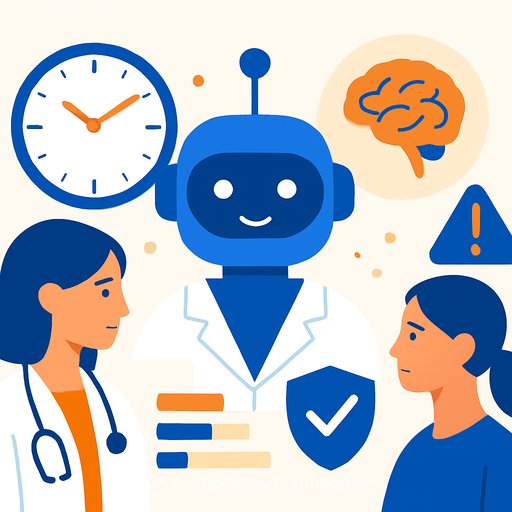AI is saving time - and changing the exam room
In clinics and hospitals, AI is already cleaning up documentation, flagging diagnoses, and crunching lab data. Tools like Nabla can listen to patient visits, draft notes, and suggest differentials so clinicians can stay present with the person, not the keyboard.
This is the upside: less administrative drag, more clinical attention. For busy teams, that's not a luxury - it's capacity.
Bias rides along with the data
AI learns from human data. That means it also absorbs human bias - the shortcuts, patterns, and blind spots baked into records, research, and documentation.
As ASU's Bradley Greger puts it, these systems are "sophisticated, probabilistic machines." Train on skewed data and you get skewed outputs. There's no leap of moral reasoning in the model.
What early studies show
A study on long-term care summaries found that two large language models behaved differently by gender. One model produced specific, clinical phrasing for men ("delirium," "chest infection"), while drifting into vague generalities for women ("health complications"). It also described women's function indirectly ("she requires assistance") while writing more directly about men ("he is disabled").
In breast cancer risk prediction, researchers found lower accuracy for African American patients compared with white patients when testing a simplified version of an advanced model. The likely driver: the original model was trained mostly on data from white patients.
Why human oversight stays non-negotiable
AI can analyze, summarize, and surface patterns. It cannot weigh values, context, or culture the way a clinician can.
Consider a 71-year-old Japanese woman with Stage 1 breast cancer who chose not to pursue treatment. Her physician honored the decision and supported her and her family through the course of illness. An algorithm would have pushed standard-of-care steps and cost logic; a clinician led with agency and empathy.
Practical playbook for healthcare leaders
- Make bias visible: Require performance stratified by sex, race/ethnicity, age, language, and payer. No stratification, no go-live.
- Demand a model card: Source data, known gaps, intended use, off-label risks, monitoring plan, and human-in-the-loop steps.
- Calibrate locally: Validate on your patient mix and equipment. Reassess after any major population or workflow change.
- Set clinical guardrails: AI drafts, clinicians decide. No autonomous denials, diagnoses, or treatment plans.
- Audit prompts and outputs: Standardize prompts for scribing and summaries. Log, spot-check, and compare to clinician notes.
- Close the loop: Build a one-click feedback path (helpful/harmful/biased). Route critical issues to governance within 24 hours.
- Protect patients: Inform them when AI assists care. Offer opt-outs where feasible. Keep PHI minimal and encrypted.
- Diversify data: Expand datasets with underrepresented groups; include social determinants when appropriate and consented.
- Measure what matters: Tie AI use to concrete outcomes: time saved, diagnostic yield, readmissions, equity gaps, patient satisfaction.
- Plan for failure: Define safe fallbacks, escalation steps, and a kill switch. Run tabletop exercises quarterly.
Clinician workflow tips
- Scribing: Prompt for SOAP structure, meds with doses, allergies, ICD-10 suggestions with rationale, and a clear to-do list.
- "Before you accept" checklist: Does this reflect the patient's words? Any overconfident claims? Missing red flags? Biased language?
- Patient-facing summaries: Generate at a 6th-8th grade level, then review for tone, accuracy, and cultural sensitivity.
Where AI is helping today
Tools are parsing blood tests, forecasting patient flow, and surfacing risk in populations. Some, like Aclarion, analyze MRI spectroscopy to highlight discs likely driving lower-back pain - converting raw signals into clinical reports that physicians review before deciding next steps.
Meanwhile, researchers and clinicians are exploring whether more granular genetic and ethnic data can reduce bias and advance prevention, such as earlier flags for diabetes risk. The promise is personalization - without losing personhood.
Policy and governance are catching up
Patients worry about algorithms making impersonal decisions - and they have reason to demand oversight. States are starting to restrict fully automated adverse decisions; clinicians must keep their hands on the wheel.
- NIST AI Risk Management Framework offers a blueprint for safer deployment.
Patient trust is earned, not assumed
More people are turning to generative AI for health questions, and many see it as reliable. In practice, that means patients arrive with AI-informed expectations - and concerns.
Set expectations early: explain where AI assists, how clinicians validate outputs, and how patients can raise issues. Transparency reduces fear and improves adherence.
Build skills, not just buy tools
Your advantage won't come from a single model. It will come from teams who can prompt well, audit outputs, and redesign workflows to keep humans in command.
If you're upskilling clinical and operations staff, you can explore curated options by role here: Complete AI Training: Courses by Job.
Bottom line
AI can reduce paperwork, surface patterns, and free clinicians to practice medicine. It can also mirror the worst biases in our data.
Deploy it with discipline: measure equity, require human oversight, and design workflows that put patient values first. That's how you get the benefits - without losing the plot.
Your membership also unlocks:






